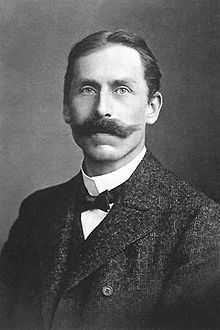Friedrich Paschen
| Friedrich Paschen | |
|---|---|
 | |
| Born |
22 January 1865 Schwerin |
| Died |
25 February 1947 (aged 82) Potsdam |
Louis Karl Heinrich Friedrich Paschen (22 January 1865 - 25 February 1947), was a German physicist, known for his work on electrical discharges. He is also known for the Paschen series, a series of hydrogen spectral lines in the infrared region that he first observed in 1908. He established the now widely used Paschen curve in his article "Über die zum Funkenübergang in Luft, Wasserstoff und Kohlensäure bei verschiedenen Drücken erforderliche Potentialdifferenz".[1]
Life
Paschen was born in Schwerin, Mecklenburg-Schwerin. From 1884 to 1888 he studied at the universities of Berlin and Strassburg, after which he became an assistant at the Academy of Münster. He became a professor at the Technical Academy of Hanover in 1893 and professor of physics at the University of Tübingen in 1901. He served as president of the Physikalisch-Technischen Reichsanstalt from 1924–33 and an honorary professor of the University of Berlin in 1925. He taught there until his death in Potsdam in 1947.
Paul Forman has written a more extensive account of Paschen's life for the Complete Dictionary of Scientific Biography.[2]
See also
- Paschen's Law
- Townsend discharge
References
- ↑ Friedrich Paschen (1889). "Ueber die zum Funkenübergang in Luft, Wasserstoff und Kohlensäure bei verschiedenen Drucken erforderliche Potentialdifferenz". Annalen der Physik 273 (5): 69–75. Bibcode:1889AnP...273...69P. doi:10.1002/andp.18892730505.
- ↑ Complete Dictionary of Scientific Biography. 2008. Encyclopedia.com. 20 Aug. 2012 <http://www.encyclopedia.com>
|